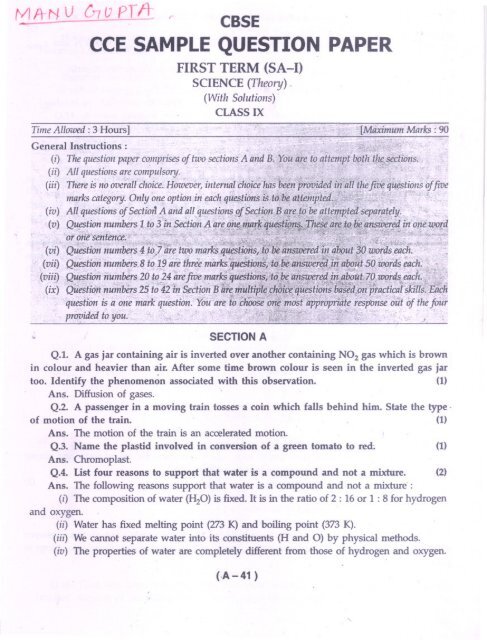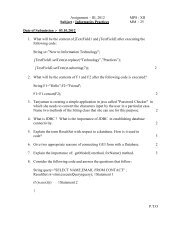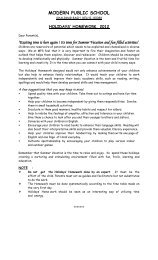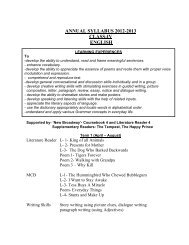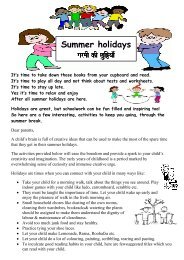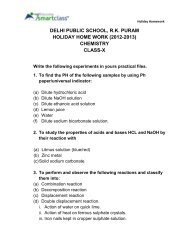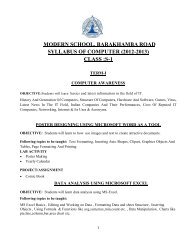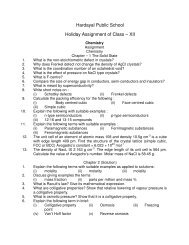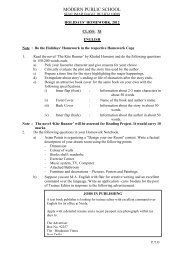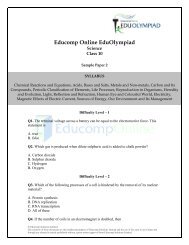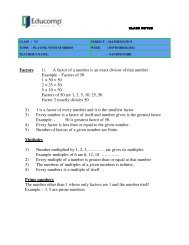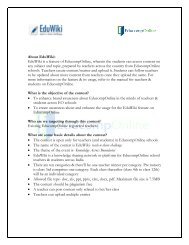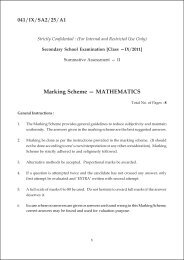CCE SAMPLE QUESTION PAPER - Educomp Online
CCE SAMPLE QUESTION PAPER - Educomp Online
CCE SAMPLE QUESTION PAPER - Educomp Online
Create successful ePaper yourself
Turn your PDF publications into a flip-book with our unique Google optimized e-Paper software.
CSSE<strong>CCE</strong> <strong>SAMPLE</strong> <strong>QUESTION</strong>FIRST TERM (SA-I)SCIENCE (Theory)(With Solutions)'CLASS IX<strong>PAPER</strong>Time Allowed: 3 Hours 1General Instructions: .(i) The question paper comprises of two sections A and R You are to attempt both t1~ sections.(iI) All questions are compulsonj.(iii) There is no overall choice. However, internal choice has been provided in all the five q~ons offivemarks category. Only one option in each questions is to be attemiJied. f' '.(iv) All questions of Sectio~ A and all questions of Section B are to be attempted separately.(v) QU!!Stion numbers I to 3 in Section A ar~.an!!,A'narkquestions. These are to be ansr1J;f!l1.,"!. ane-wordor one"sentence. ,~ ". v· " . ...:. ~ ' ...., .. - .' "" -(vi) Q~tion numbers 4'loJ :Ue two marksquestioris, to be.answered in, qbput '30wo~ds ~d,.(viI) Question numbers.8 to 19 are three marks questions; to be answered m-abaut 50 Words each. ,(viiI) Question numbers 2010/4 are five"!f1rks questiOns, to .b~ answered ii~p?ut 70 words, ea~h..(ix) Question numbers 25 to 42 in Sfction B kre multiple choice qw;stions baSedpl1 ptacticol skills. Thcnquestion is a aile mark question. You are to c1Wose one mOst izppropriate response oUt of the Jourprovided to you. ~SECTIONQ.l. A gas jar containing air is inverted over another containing NOz gas which is brownin colour and heavier than air. After some time brown colour is seen in the inverted gas jartoo. Identify the phenomen~n associated with this observation. (1)Ans. Diffusion of gases.Q.2. A passenger in a moving train tosses a coin which falls behind him. State the type.of motion of the train. (1)Ans. The motion of the train is an accelerated motion.Q.3. Name the plastid involved in conversion of a green tomato to red. (1)Ans. Chromoplast.Q.4. List four reasons to support that water is a compound and not a mixture. (2)Ans. The following reasons support that water is a compound and not a mixture :(i) The composition of water (H20) is fixed. It is in the ratio of 2 : 16 or 1 : 8 for hydrogenand oxygen.(ii) Water has fixed melting point (273 K) and boiling point (373 K).(iii) We cannot separate water into its constituents (H and 0) by physical methods.(iv) The properties of water are completely different from those of hydrogen and oxygen.(.A-41 )A
A-42Q.5. A man weighs 600 N on the surface of earth. What would be his mass and weighton the surface of moon ? (Take gearth = 10 m/s2). (2)Ans. As per question weight of a man on the surface of earth Wearth = 600 Nand gearth= 10 m/s2Mass of man on the surface of moon = Mass of man on the surface of earthm = Wearth = 600 N = 60 kggearth 10 m/s2Weight of man on the surface of moon Wmoon = m.gmoon·= 1Il.gearth 6 = Wearth 6(i) Homogeneous (ii) There homogeneous composition between is mixture no boundary mixture. throughout has uniform of its separation mass.= 600N = 100 N.6Q.6. State one feature that is similar and one feature that is dissimilar with respect to .mitochondria and plastids. (2)Ans. Similar feature: Both have their own DNA and ribosomei to make their own proteins.Dissimilar feature: Mitochondria are the site of cellular respiration (power house of cell) whilechloroplasts are centre for photosynthesis (food factory of cell).Q.7. Show'the location of meristematic tissues in a plant diagrammatically. Which meristemis responsible for the transformation of the stem of a plant into the trunk when it grows intoa tree? (2)Ans.Apical meristemIntercalary meristemLateral meristemLateral meristem transfonns stem of a plant into trunk of tree.. Science-IXQ.8. (a) A spoonful of sugar is added to a beaker containing 500 mL of water and stirredfor a while. State any two observations that you will make.(b) Account for your observations. (3)Ans. (a) On dissolving sugar in water, we observe that(i) sugar dissolves completely in water.(ii) there is no change in the volume.(b) The above observations can be explained by saying that there is lot of empty space betweenwater molecules. Sugar molecules occupy these empty spaces and, therefore, there is no change involume of the solution. ..l. '.eSSE eeE Sample Question PaperAns. Distinction between homogeneous and heterogeneous mixtures is given below :a constituentsof between the the constituents of a heterogeneousHomogelleolls mixture Heterogelleolls uniform mixture. (i) (ii) Heterogeneous Therecomposition is amixturevisible mixture throughtout boundary doesof not its separation mass. have a---+time(s)A-4~Q.9. Distinguish between homogeneous and heterogeneous mixtures. Classify thefollowing mixtures as homogeneous and heterogeneous :(i) Tincture of iodine(ii) Smoke(iii) Brass(ip) Sugar solution. (3)Classificationof mixtures:(i) Tmcture of iodine Homogeneous(ii) Smoke Heterogeneous(iii) Brass Homogeneous(iv) Sugar solution Homogeneous.Q.10. Derive graphically the equation for position-time relation for an object travelling adistance's' in time 't' under uniform acceleration. (3)Ans. The velocity-time graph has been shown in figure.At t = D, the initial velocity is u (at point A) and then 1, S____________________ Bincreases to v (at point B) in time t. .s >v ! IDraw perpendicular lines BC and BE from point B on the .?: .- : Itime and velocity axes respectively, so that OA = u, OE = BC ~ I~ I~v. > IAlso draw a line AD parallel to time axis, so that OC = AD = t.t --------------fDThen change in velocity in time t = BC - OA = BC - CD = BD eltBut BC = v and CD = OA = It 0Hence, BD = v - u.According to velocity-time graph, the total distance covered by the object is obtained by the '.area under the graph.Hence, distance s travelled by the object = area of the trapezium OABC= area of rectangle OADC + area of triangle ADB1= OA x OC + -(AD x BD)2But OA = It, OC = t, AD= OC = t and BD = change in velocity = v - u = at, where a = uniformacceleration of the object.1 1s = ut + - (t x at) = ut + - at2.2 2Q.ll. State the law of inertia. Why do we fall in the forward direction if a moving busstops suddenly and fall in the backward direction if it suddenly accelerates from rest? (3)
, Science-IXA-46Ans. Distinction between striated muscles, smooth muscles and cardiac muscles :pump they They parts involuntary. Cardiac Smooth movement. according i.e., Do help not invollmtary of are blood body.muscles work also heart to to Example: will all to "Striated musclesmixtureStabilitysmall. paper system. on particle pass do keeping. not through because settle size Its Type Filterability particles is down averythe of filterThe labelled diagram of the muscle tissue which never shows fatigue is shown below:StriationseSSE eeE Sample Question Paper A-Q.20. (a) Distinguish among true solution, suspension and colloid in a tabular form underthe following heads :(i) Stability (ii) Filterability(iii) Type of mixture(b) What is meant by concentration of a solution? How will you prepare a 10% solutionof glucose in water? (5)Ans. (a) Distinction behveen "true solution, suspension and colloid considering the factorsstability, filterability and type of mixture is gi\'en below in the tabular form:Property homogeneous.The Solutions SO/Iltioll soluteSuspensionsbecause size the do Suspendedheterogeneous.but Suspensioll after settle asystem. through Colloidal isarestable particles asmall.not filter stable issome ColloidColloids appear down large. pass system. Its the paper settle are particles a time.homogeneous.throughis on filter hete~ogeneousare not down keeping. Itspaperpass do sizenotNucleiCardiac musclesQ.17. Which cell organelle would you associate with elimination of old and worn outcells? Why? (3)Ans. Lysosomes. They are capable of breaking down all organic material and keep the celldear by digesting worn out cell organelles. They are membrane bound sacs filled with powerful,iigestive enzymes. When the cell is worn out and needs to be destroyed, the Iysosomes burst andthe enzymes digest the cell.Q.18. State one difference between dugwells and tubewells. Explain any two freshinitiatives taken to increase the water available for agriculture. (3)Ans. Dugwells : In a dugwell, water is collected from water bearing strata.Tubewells : Tubewells can tap water from deeper strata. From these wells, water is lifted bypumps for irrigation.Fresh initiatives for increasing the water available for agriculture includes:(i) Rainwater harvesting, and .(ii) Water shed management.This involves building small check dams which lead to an increase in ground water level. Thecheck dams stop the rainwater from flowing away and also reduce soil erosion.Q.19. (a) Which two factors bring about loss of food grains during storage ? Give oneexample for each.(b) State any two control measures to be taken before grains are stored. (3)Ans. (a) Factors which bring about loss of food during storage :(i) Biotic (living) e.g., insects/rodents/fungi/mites.(ii) Abiotic (non-living) e.g., inappropriate temperature/humidity at the place of storage.(b) (i) Strict cleaning of the product before storage.(ii) Proper drying of the product first in sunlight and then in shade and fumigation usingchemicals that can kill pests.(b) Concentration of solution is defined as the amount of the solute present in a givenamount (mass or volume) of the solution (or solvent).A 10 per cent solution (by mass) of glucose can be prepared by dissolving 10 g of glucose in90 g of water, so that the total mass of the solution is 100 g.Or(a) Draw a neat and labelled diagram of the apparatus used to separate components ofblue-black ink. Name the process and state the principle involved.(b) Identify the physical and chemical changes from the following:(i) Burning of magnesium in air.(ii) Tarnishing of silver spoon.(iii) Sublimation of iodine.(iv) Electrolysis of water.Ans. (a)Glass rodStripof filterpaperLinedrawnby pencilSpot of ink(a)(b)The process involved in the separation of componentsPaper clipsJarStripof filterpaperof blue-black ink is called chromatography,
-48 .. , Science-IXPrinciple: The coloured component thatattraction forcesis morespaces Kinetic Inter-particle ofsoluble in water rises faster and in this way theof particles energy compressible.unchanged. keep kineticInter-particletheenergy.shapeconstant.colours of different dyes present in blue black ink get separated.(b) Physical and chemical changes:(i) Burning of magnesium in air Chemical change(ii) Tarnishing of silver spoon Chemical change(hi) Sublimation of iodine Physical change(iv) Electrolysis of water Chemical changeQ.21. (a) State one similarity and one difference between evaporation and boiling.(b) List four factors which affect the rate of evaporation.(c) Describe an activity to show that water vapour is present in air.(5)Ans. (a) Similarity: The liquid state changes into the gaseous state.Difference: Evaporation can take place at any temperature while boiling takes place at a fixedtemperature. For example, evaporation of water can take place at any temperature while boiling ofwater takes place at 100°C only.(b) Factors that affect the rate of evaporation: The following factors affect the rate ofevaporation:(i) Surface area· of the liquid exposed to air.(ii) Temperature of the liquid.(iii) Humidity of the surrounding air.(iv) Wmd velocity.(c) Activity to show that water vapour is present in air:Characteristic:r-Waterdrops3 Crushed ice(i) Take about 200 g crushed ice in a tumbler.(ii) Keep it in the open for about 15 minutes.We shall find that water droplets are seen on the outside surface of the tumbler.This is because the water vapours in the air comes into contact with the cold surface of thetumbler and are condensed to water droplets.OrDistinguish solids, liquids and gases in a tabular form under the following characteristics:(i) Rigidity(ii) Compressibility(iii) Inter-particle forces of attraction(iv) Inter-particle spaces(v) Kinetic energy of particles.Ans. Distinction between soUds, liquids and gases covering the required points is givenbelow in tabular fonn .Solids expand fluids. Gases easily. Liquids i.e., Solids arethey rigid. are They to are can completely any fluids, can flow volume.CSSE <strong>CCE</strong> Sample Question PaperA-49Compressibilityparticles of a gas.Solids They inter-particleattractions between Negligiblepossess volume energy. compressed They inter-particleweek are notGases attractions. might move force Some Highly have can of strongandVery space directions. between Particles possess particles very the particles large space freely is inter-particlechange haveparticles. compressible.remains low high attraction. there.bespaceweaker The aextremelyslightly.liquid gas kinetic can !Jut all shape theQ.22. Define momentum. State its SI unit.An object of mass 50 kg is accelerated uniformly from a velocity of 4 m S-1 to 8 m s-1 in 8 s.Calculate the initial and final momentum of the object. Also find the magnitude of the forceexerted on the object. .' (5)Ans. The total quantity of motion contained in an object is called its momentum.Mathematically, momentum of an object is given by the product of its mass and velocity.:. Momentum (P) = mass (m) x velocity (v)Momentum has both magnitude and direction i.e., it is a vector. S1 unit of momentum is1kgms-l.It is given that mass of object In = 50 kg, initial velocity u = 4 m s-l, final velocity v = 8 m s-I and~time t = 8 s.:. Initial momentum of objectFinal momentumPI = mu = 50 x 4 = 200 kg m s-Iof objectP2 = "!v = 50 x 8 = 400 kg m S-IForce exerted on the objectF = P2 - PI = 400 - 200 = 25 N.t 8OrState the law of conservation of momentum. Why is a person hit harder when he falls on ahard floor than when he falls on sand from the same height?A bullet of mass 20 g is fired horizontally with a velocity 100 m s-1 from a pistol of mass1.5 kg. Calculate the recoil velocity of the pistol.Ans. According to the principle of conservation of momentum, for an isolated system (i.e.,when no external unbalanced force is acting on the system) the total momentum of the systemremains conserved. It is a basic conservation law of nature and is always true (or it never fails).As an illustration if two objects moving on a smooth floor collides, then the sum of momenta ofthe two objects before collision is equal to the sum of their momenta after collision. .When a person falls from a height on a hard concrete floor, he immediately comes in restposition. It means change in momentum is taking place in an extremely short time and consequently,
50, Science-IX)fce exerted by the floor on the person to destroy its momentum is extremely large. Hence, chancesf more injuries. When a person falls ,?n a sandy surface, the surface gets compressed downwardnd it increases the time of fall. As a result for same change in momentum force exerted by sandyurface on the person is less and chances of his being hurt are less.As per question mass of bullet 111 = 20 g = 0.02 kg, muzzle velocity of bullet v = 100 In s-1, and the:lass of pistol M = 1.5 kg1/1I' 0.02 x 100 1:. Recoil velocity of the pistol V = - - = - ---- = - 1.33 m s-M 1.5I~eSSE eeE Sample Question PaperDistance covered 5 = .!.[15 x 30] = 225 m.2OrThe velocity-time graph of a body is given as follows:~\n40~~ .s 20 ItABA-\.The negative sign indicates that the direction of recoil of pistol is opposite to the direction ofnotion of bullet.Q.23. The velocity-time graph for an object is shown in the following figure.50o10 20_Time(s)30C4010o510 15_Timet(s)(i) State the kind of motion that the above graph represents.(ii) What does the slope of the graph represent?(iil) What does the area under the graph represent ?(iv) Calculate the distance travelled by the object in 15 s.Ans. (i) As velocity-time graph is a straight50line inclined to the axes, it represents a uniformly:l.ccelerated motion.(ii) The slope of the graph represents· the 1, 40value of uniform acceleration of the object. .s(iii) .The area under the graph represents ~ 30the distance covered by the object d':lring a given gtime. ~(iv) From the graph distance travelled by t 20the object in 15 s = area under velocity-time= area of triangle OAB1, 40.s > -0 ~ 30o~t 20graph102015 = -[OB x BA]2 0From the graph OB = 15 sand BA = OC = 30 m s-125Ḇ --r-5 10 15 20_Time(s)25(5)(i) State the kind of motion represented by OA; AB.(ii) What is the velocity of the body after 10 s and after 40 s ?(iil) Calculate the retardation of the body.(iv) Calculate the distance covered by the body between 10th and 30th second.Ans. (i) The graph line OA represents uniformly accelerated motion but the line AB representsuniform linear motion.(ii) Velocity of the body after 10 s is ~In 4020 m s-1 and after 40 s the velocity is zero. .s(iii) The motion is a retarded motion ~between 30 sand 40 s. In this duration, velocity ~ 20~-~ O-W Ifalls from 20 m ~-1 to o. >t Lh:Retardation a = --- = --- I Et2 - t1 40 - 30 0 10 20=-2ms-2 _ Time(s)(iv) Distance covered by the body between 10th and 30th second= Area of the rectangle EABD = EA x ED= (20 m s-l) x (30 s -10 s) = 20 x 20 = 400 m.Q.24. How can crop variety improvement methods come to the rescue of fanners facingrepeated crop failures ? Describe three factors for which they could do crop improvement.Which is the most common method of obtaining improved variety of crops? Explain briefly.(5)Ans. Three factors for which farmers could do crop improvement :(i) Biotic and abiotic resistances: Crop production can go down due to biotic (diseases,insects and nematodes) and abiotic (drought, salinity, water logging, heat, cold and frost), stressesunder different situations. Varieties resistant to these stresses can improve crop production.(ii) Change in maturity duration : The shorter the duration of the crop from sowing toharvesting, the more economical is the variety.-Such short durations allow farmers to grow multiplerounds of crops in a year. Uniform maturity makes the harvesting process easy and reduce~ lossesduring harvesting.AB30c +-40
,.; 52 U-Like Science-IX eSSE eeE Sample Question Paper A-53(iii) Wider adaptability: Developing varieties for wider adaptability will help in stabilisingthe crop production under different envirorunental conditions. One variety can then be grownunder different climatic conditions in different areas.Most corrunon method is Hybridisation which involves crossing two varities having genes fordesired characteristics and bringing them together into a new \'ariety called hybrid.OrA poultry farmer wants to increase his broiler production. Explain three managementpractices he must follow to enhance the yield.In what way is the daily food requirement of broilers different from those of egg layers?Ans. (a) Management practices the farmer must follow to enhance the yield are:(i) Maintenance of temperature: To much high or low temperature affects the growth ofbroilers.(ii) Provision of hygienic conditions in housing and broiler feed.(iii) Prevention and control of diseases and pests.(b) Broiler chickens must be fed with protein rich with adequate fat, vitamins A and K dietsfor good growth rate and better feed efficiency.SECTIONQ.25. Four students prepared mixtures in wat~r by taking sugar, sand, chalk powder andstarch respectively, in four different test tubes. After stirring, the mixture that appeared clearand transparent was that of (1)(a) starch and water.(b) chalk powder and water.(c) sand and water.(d) sugar and water.Ans. (d) Out of sugar, sand, chalk powder and starch, only sugar is soluble in water.Q.26. Rohit mixed starch with water, boiled the mixture well and stirred it. He observedthat(l)(a) starch floats on the surface of water.(b) starch settles down at the bottom.(c) starch forms a translucent mixture.(d) starch forms a transparent mixture.Ans. (c) Starch forms a colloidal solu?on with water, which is translucent.Q.27. You are provided with a mixture of iron filings and sulphur powder. When you addcarbon disulphide to the mixture, you would observe (1)(a) iron particles dissolve and the solution turns black.(b) sulphur powder dissolves and the solution turns colourless.(c) sulphur powder dissolves and the solution turns yellow.(d) iron particles dissolve and the solution turns grey.Ans. (c) Iron particles do not dissolve in carbon disulphide. Sulphur dissolves in carbondisulphide forming a yellow solution.Q.~8. A strip of magnesium metal is burnt in the flame. It is observed that (1)(a) a yellow light appears.(b) a white dazzling light appears.B(c) magnesium starts melting.(d) lot of black smoke is produced.Ans. (b) Magnesium metal burns in the flame with a white dazzling light.Q.29. For determining the melting point of ice, the thermometer should be kept (l)(a) with its bulb in the ice cubes.(b) in contact with the inner wall of the beaker.(c) a little above the ice cubes.(d) in touch with the beaker from outside.Ans. (a) A correct melting point will be obtained only if the thermometer is kept with itsbulbs in the ice cubes. In any .other conditions (b), (c) or (d), the temperature obtained will bedifferent from melting point.Q.30. A student takes some water in a beaker· and heats it over a flame for determining itsboiling point. He keeps on taking its temperature reading. He observes that the temperatureof the water (1)(a) keeps on increasing regularly.(b) keeps on increasing irregularly.(c) first increases slowly, then decreases rapidly and eventually becomes constant.(d) first increases gradually and then becomes constant.Ans. (d) The temperature keeps increasing till the boiling points is reached. At the boilingpoint, the temperature becomes constant.Q.31. The colour of sodium chloride 'and ammonium chloride respectively is (1)(a) yellow and white.(b) white and yellow.(c) both are white.(d)' grey and yellow.Ans. (c) Both sodium chloride and arrunonium chloride are white coloured compounds.Q.32. In the laboratory, carbon disulphide is used as a solvent to separate a mixure of ironfilings and sulphur powder. What precaution has to be taken with carbon disulphide 7 (1)(a) Keep away from water.(b) Keep away from flame.(c) Keep away from air.(d) Keep away from iron sulphide.Ans. (b) Carbon disulphide is an inflarrunable compound. Therefore, it has to be kept awayfrom flame.Q.33. When iron nails are placed in copper sulphate solution, after 10 minutes, its bluecolour disappears and the solution appears (1)(a) reddish brown (b) blue(c) light blue (d) greenishAns. (d) The following reaction takes placeFe + CuS04 ~ FeS04 + CuFerrousSulphate(green colour)
A-54Science-IX eSSE eeE ~ample Question Paper A,Q.34. In an experiment to separate the. components of a mixture of sand, common salt andammonium chloride, the component which will be removed by filtration is (1)(a) sand (b) common salt(c) ammonium chloride (d) none of theseAns. (n) In fact anunonium chloride is first remQ\'ed by sublimation. Then we dissolve themixture in water. Conunon salt dissolves leaving behind sand which is separated by filtration.Q.35. To study the third law of motion, following sets of apparatus are available in alaboratory : (1)Set (i) One spring balance, two weight boxes, inextensible thread, one pulley with a clamp,two pans of known mass.Set (ii) Two identical spring balances, one weight box, inextensible thread, one frictionlesspulley with a clamp, one pan of known mass, a rigid support.Set (iii) Four identical spring balances, two pulleys, inextensible thread, two clamps, two pansof known masses, two rigid support.Set (iv) Two identical spring balances, two weight boxes, two rigid supports, two pans ofknown masses, inextensible thread, two frictionless pulleys with clamps.To perform the experiment successfully by using minimum apparatus, the best choicewould be:(a) Set (i) (b) Set (il)(c) Set (iii) (d) Set (iv)Ans. (b) To perform the experiment successfully by using minimum apparatus, the bestchoice would be Set (ii) in wh.ich we use two identical spring balances, one weight box, inextensiblethread, one frictionless pulley with a clamp, one pan of known mass and a rigid support.Q.36. For doing the experiment, "to study the third law of motion using two springbalances", four students A, B, C and D set up their apparatus as shown below: (1)---- ----'e\ PulleyPan(B)The best set up is that of(a) student A(c) student C(C)(A)PanPan(b) student B(d) student D(0)PanAns. (a) The best set up is that of student A because in this set up both the spring balance1>are set exactly in horizontal position.Q.37. The appearance of magenta colour, on adding cone. Hel to a given sample of solutionof dal confirms the presence of (1)(n) argemone oil in the dal.(b) potassium dichromate il1'the dal.(c) saw dust in the dal.(d) metanil yellow in the dal.Ans. (d) Metanil yellow on reacting with cone. HCl gi\'es magenta colour.Q.38. The steps for conducting the starch test on the given sample of rice grains are (l)(i) crush the rice grains.(ii) add water to the test tube.(iii)(iv)(a)add few drops of iodine.boil the contents and filter.The most appropriate order in which the steps should followed are:W~~~~W~~~~(c) (iii), (iv), (I), (il) (d) (I), (ii), (iv), (iii)Ans. (d) After crushing rice, water is added to it and then after boiling it, starch solution isobtained. Lastly iodine solution is added to detect the presence of starch.Q.39. While preparing a temporary mount of the cheek cells, the reason behind stainingthe cells is (1)(a) to prevent the cells from drying quickly.(b) to preserve them.(c) to disinfect them.(d) to make the organelles clearly visible.Ans. (d) Cell organelles when stained become more visible.Q.40. Which of the observations noted by Arun about the parenchyma tissue is not correct?(l)The cells are are thin walled.(b) Large cells are placed together with intercellular spaces.(c) The cells are loosely packed.(d) The cells are thick walled.Ans. (d) Characters given in (a), (b) and (c) are identifying features of parenchyma tissue.Q.41. The formula used to calculate the percentage of water absorbed by raisins is (1)W2 in the formula refers to :W-W2__WI(a) mass of raisins before absorption of water.(b) mass of raisins after absorption of water.(c) mass of water left in the beaker at the end.(d) mass of water absorbed by the raisins.Ans. (b) This is the correct answer.1 x100
Science-IXQ.42. One of the following shows the correct diagrammatic representation of a striatedmuscle fibre when seen under the low power of a microscope ? (1)The correct answer is(A) (B) (C) (D)(a) A (b) B(c) C (d) DAns. (a) In striated muscles their are more than one nuclei located towards the periphery ofcell and the striation is alternate.


